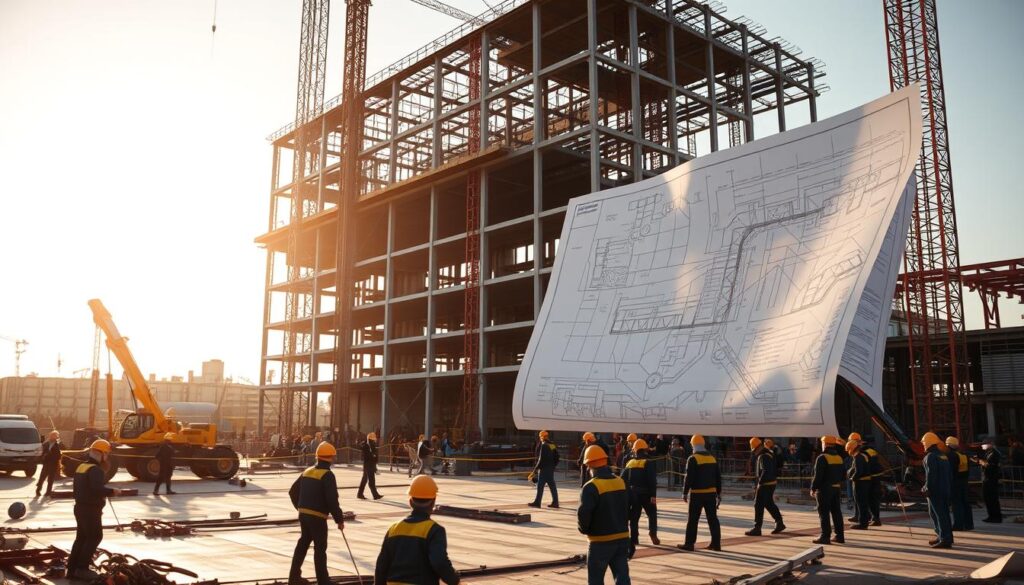Managing a construction timeline effectively is crucial for the success of any building endeavor. It ensures that the work is completed on schedule, stays within budget, and meets the expectations of all stakeholders involved.
A well-planned project timeline is the backbone of efficient project management. It involves meticulous planning, coordination, and monitoring of various tasks and milestones. By mastering the art of creating and managing these timelines, professionals in the industry can significantly enhance their ability to deliver projects on time and within budget.
Key Takeaways
- Understand the critical components of a construction project timeline.
- Learn methodologies for creating and managing effective timelines.
- Discover best practices for adhering to project schedules.
- Identify common challenges in timeline management and how to overcome them.
- Enhance your project management skills to ensure successful project delivery.
The Critical Role of Timelines in Construction Projects
The importance of timelines in construction projects cannot be overstated, as they directly impact project profitability and client satisfaction. Timelines serve as the roadmap for construction projects, guiding the sequence of events and ensuring that all stakeholders are aligned.
Why Effective Timeline Management Matters
Effective timeline management is crucial for the success of construction projects. It ensures that projects are completed on time, which is vital for maintaining client satisfaction and avoiding financial penalties.
Impact on Project Profitability
A well-managed timeline helps in reducing costs associated with delays and extensions. Key benefits include:
- Reduced labor costs due to minimized overtime
- Lower costs for extended equipment rentals
- Avoidance of penalty clauses for late completion
Client Satisfaction Factors
Meeting project deadlines is essential for client satisfaction. Factors influencing client satisfaction include:
- Timely completion of project milestones
- Regular updates and transparent communication
- Flexibility in adapting to changes or unforeseen issues
The Cost of Poor Timeline Planning
Poor timeline planning can lead to significant financial losses and reputational damage. The consequences include financial penalties, project overruns, and a tarnished reputation.
Financial Penalties and Overruns
Delays often result in financial penalties and cost overruns. These can arise from:
- Late completion penalties
- Increased material and labor costs due to inflation or scarcity
- Costs associated with resolving disputes or claims
Reputation Management
A company’s reputation is at stake when timelines are not met. Maintaining a good reputation requires:
- Consistent delivery on time
- Proactive communication about project status
- Quality workmanship and attention to detail
Construction Project Timeline Guide: Essential Components
A well-structured construction project timeline is the backbone of any successful building endeavor. It serves as a critical tool for project managers to coordinate various tasks, allocate resources, and ensure that the project is completed on time and within budget.
Defining Project Milestones
Defining project milestones is a crucial aspect of creating a comprehensive timeline. Milestones represent significant events or accomplishments in the project lifecycle, such as completing the foundation work or obtaining necessary permits. By establishing clear milestones, project managers can track progress, identify potential delays, and make informed decisions to keep the project on track.
Creating Realistic Timeframes
Creating realistic timeframes is essential to ensure that the project milestones are achievable. This involves considering various factors, including weather conditions, resource availability, and potential roadblocks. By building in buffers for unexpected delays, project managers can minimize the risk of timeline slippage and ensure that the project stays on schedule.
U.S. Construction Industry Standards
Adherence to U.S. construction industry standards is vital to ensure compliance with regulatory requirements and industry best practices. This includes following guidelines set by organizations such as the American Society of Civil Engineers (ASCE) and the Construction Industry Institute (CII). By adhering to these standards, project managers can ensure that their timeline is aligned with industry norms and that the project is executed to the required quality standards.
As
“A well-planned construction project timeline is essential for delivering projects on time, within budget, and to the required quality standards.”
By focusing on essential components such as project milestones, realistic timeframes, and adherence to industry standards, project managers can create a comprehensive timeline that guides the project team to success.
Pre-Construction Timeline Planning
Pre-construction timeline planning is a critical step that determines the trajectory of the entire construction project. It involves a series of strategic decisions that lay the groundwork for a successful project execution.
Site Analysis and Preparation
Site analysis and preparation are foundational elements of pre-construction planning. This phase involves assessing the site’s topography, environmental conditions, and existing infrastructure to identify potential challenges and opportunities. Effective site preparation ensures that the land is ready for construction, minimizing the risk of delays and cost overruns.
Permit Acquisition in U.S. Jurisdictions
Permit acquisition is a critical aspect of pre-construction planning, requiring compliance with various U.S. jurisdictional regulations. Understanding local permitting requirements is essential to avoid legal issues and project delays. This involves submitting detailed plans and undergoing reviews by local authorities.
Resource Allocation Planning
Resource allocation planning is vital for ensuring that the necessary labor and materials are available when needed. This involves strategic planning to allocate resources efficiently, minimizing waste and reducing the risk of project delays.
Labor Requirements
Assessing labor requirements is a crucial component of resource allocation. This involves determining the number of workers needed, their skill levels, and the timeline for their involvement. Effective labor planning helps in managing costs and ensuring that the project stays on schedule.
Material Delivery Scheduling
Material delivery scheduling is another key aspect of resource allocation. It involves coordinating with suppliers to ensure that materials arrive on time, reducing the risk of delays and storage costs. Just-in-time delivery strategies can be particularly effective in managing material logistics.
Timeline Methodologies for Construction Projects
Mastering construction project timelines requires an understanding of various management methodologies. Effective timeline management is the backbone of any successful construction project, ensuring that projects are completed on time and within budget.
Critical Path Method (CPM)
The Critical Path Method (CPM) is a step-by-step project management technique that identifies critical tasks that determine the project duration. By focusing on the critical path, project managers can allocate resources more efficiently and mitigate potential delays. “CPM is essential for complex construction projects as it helps in prioritizing tasks and managing dependencies,” says a construction management expert.
Gantt Charts and Their Applications
Gantt charts provide a visual representation of the project timeline, making it easier to track progress and identify potential bottlenecks. They are particularly useful for illustrating the project schedule and dependencies between tasks. As noted by a project management specialist, “Gantt charts are invaluable for communicating project timelines to stakeholders and team members.”

Agile and Lean Construction Approaches
Agile and Lean construction approaches offer flexible and efficient ways to manage construction projects. These methodologies focus on minimizing waste and maximizing value, allowing for adaptability in response to changing project requirements. A construction industry report highlights that “adopting Agile and Lean principles can significantly improve project delivery times and reduce costs.”
By leveraging these timeline methodologies, construction projects can enhance their planning, execution, and overall success rates.
Digital Tools for Construction Project Timeline Management
In the construction industry, the adoption of digital tools has become a game-changer for project timeline management, offering unprecedented levels of efficiency and accuracy. These tools have transformed the way construction projects are planned, executed, and monitored.
Project Management Software Options
Project management software is a critical component of modern construction project timeline management. It offers a range of functionalities, from scheduling to resource allocation, that are essential for keeping projects on track.
Cloud-Based Solutions
Cloud-based project management solutions provide the advantage of accessibility from anywhere, at any time, facilitating real-time collaboration among team members. This flexibility is crucial for construction projects where teams are often dispersed across different locations.
BIM Integration for Timeline Planning
The integration of Building Information Modeling (BIM) with project management software enhances the accuracy of timeline planning by providing a detailed digital representation of the project’s physical and functional characteristics. This integration enables more precise scheduling and resource allocation.
| Feature | Cloud-Based Solutions | BIM Integration |
|---|---|---|
| Accessibility | Accessible from anywhere | Enhances detail accuracy |
| Collaboration | Facilitates real-time collaboration | Improves scheduling precision |
| Scalability | Scalable to project needs | Reduces errors in planning |
Mobile Applications for On-Site Timeline Tracking
Mobile applications have become indispensable for on-site timeline tracking, enabling real-time progress monitoring and team collaboration.
Real-Time Progress Monitoring
With mobile applications, project managers can monitor progress in real-time, making it easier to identify and address potential delays promptly.
Team Collaboration Features
These applications also offer features that enhance team collaboration, such as the ability to share updates, assign tasks, and communicate instantly.
By leveraging these digital tools, construction projects can achieve better timeline management, leading to improved project outcomes.
Common Timeline Challenges and Effective Solutions
Despite meticulous planning, construction timelines can be derailed by various factors. Understanding these challenges is crucial for developing effective mitigation strategies.
Weather-Related Delays in Different U.S. Regions
Weather conditions vary significantly across the United States, impacting construction project timelines. For instance, hurricane-prone areas like Florida and the Gulf Coast experience severe weather during certain months, while regions like the Northeast face harsh winters. Developing region-specific contingency plans can help mitigate these delays.
Supply Chain Disruptions
Supply chain disruptions can lead to material shortages, delaying construction activities. To address this, diversifying suppliers and maintaining robust inventory management systems are essential strategies.
Labor Shortages and Skilled Trade Availability
Labor shortages, particularly in skilled trades, pose significant challenges to construction timelines. Investing in workforce development and adopting innovative construction technologies can help alleviate these shortages.
Scope Creep Management
Scope creep, or changes in project scope, can derail timelines if not managed effectively. Implementing strict change management processes and maintaining clear communication with stakeholders are key to controlling scope creep.
By understanding and addressing these common challenges, construction project managers can develop effective solutions to keep their projects on track.
Best Practices for Timeline Adherence
Maintaining a construction project’s timeline requires a combination of effective tracking, communication, and motivation strategies. By implementing these best practices, project managers can significantly improve the likelihood of completing projects on schedule.
Daily Progress Tracking Methods
Daily progress tracking is essential for identifying potential delays early. Methods include using construction management software to log daily activities, conducting regular site inspections, and maintaining a detailed log of work completed. For instance, Procore, a popular construction management platform, allows for real-time tracking and reporting.
Effective Communication Protocols
Clear and consistent communication among all stakeholders is vital. This includes regular project meetings, transparent reporting of progress and issues, and using collaboration tools like Slack or Microsoft Teams for real-time updates. Effective communication helps in addressing issues promptly and keeping everyone aligned with project goals.
Incentive Structures for On-Time Completion
Incentives play a crucial role in motivating teams to work efficiently. Two effective incentive structures are:
Contractor Bonus Systems
Implementing a bonus system for contractors can significantly boost their motivation to complete work on time. For example, a bonus for meeting key milestones can encourage contractors to allocate resources more effectively.
Team Recognition Programs
Recognizing team achievements through programs like “Employee of the Month” or public acknowledgment at project meetings can enhance morale and productivity. It’s a simple yet effective way to encourage teams to adhere to the project timeline.
| Best Practice | Description | Benefit |
|---|---|---|
| Daily Progress Tracking | Using software to log daily activities | Early identification of potential delays |
| Effective Communication | Regular meetings and transparent reporting | Prompt issue resolution and alignment with project goals |
| Incentive Structures | Contractor bonuses and team recognition | Motivation for on-time completion |
Managing Stakeholder Expectations Throughout the Timeline
Managing stakeholder expectations is a critical component of construction project management, ensuring that all parties are informed and aligned with project progress. This involves implementing effective strategies for client communication, subcontractor coordination, and regulatory compliance updates.
Client Communication Strategies
Clear and consistent client communication is essential for managing expectations and ensuring client satisfaction. This can be achieved through regular project updates, transparent reporting, and prompt addressing of client concerns. By keeping clients informed, construction project managers can build trust and reduce the likelihood of misunderstandings.

Subcontractor Coordination
Effective subcontractor coordination is vital for ensuring that all parties work together seamlessly. This involves clear communication of project timelines, expectations, and requirements. By coordinating subcontractor activities, project managers can minimize delays and ensure that project milestones are met.
Regulatory Compliance Updates
Regulatory compliance is a critical aspect of construction project management. Staying up-to-date with local code requirements and federal regulations is essential for avoiding delays and ensuring project compliance.
Local Code Requirements
Local code requirements can vary significantly between jurisdictions, making it essential to understand the specific regulations applicable to the project location.
Federal Regulations Impact
Federal regulations can also impact construction projects, particularly those involving government funding or infrastructure development. Staying informed about changes to federal regulations is crucial for maintaining project compliance.
Timeline Recovery: Getting Back on Schedule
Construction projects often face unforeseen delays, making timeline recovery a critical skill for project managers. Despite the best efforts, projects can fall behind schedule due to various factors. Recognizing the early warning signs of timeline slippage is crucial for taking corrective action.
Early Warning Signs of Timeline Slippage
Identifying potential delays early is key to effective timeline recovery. Some early warning signs include:
- Slower than expected progress
- Increased overtime without corresponding productivity gains
- Supply chain disruptions
- Changes in project scope
By monitoring these indicators, project managers can take proactive measures to mitigate delays.
Fast-Tracking Techniques
Fast-tracking involves performing tasks in parallel that were originally scheduled to be done sequentially. This technique can significantly accelerate project progress. Some effective fast-tracking techniques include:
- Overlapping design and construction phases
- Pre-fabricating building components
- Implementing advanced construction technologies
Fast-tracking requires careful planning to avoid rework and ensure that quality is not compromised.
Resource Reallocation Strategies
Resource reallocation involves adjusting the allocation of labor, equipment, and materials to optimize project progress. Effective strategies include:
- Reassigning personnel to critical tasks
- Renting additional equipment to meet demand
- Sourcing materials from alternative suppliers
Emergency Staffing Solutions
In cases of severe labor shortages, emergency staffing solutions can help. This may involve hiring temporary workers or contracting specialized labor.
Alternative Material Sourcing
Sourcing materials from alternative suppliers can help mitigate supply chain disruptions. This requires maintaining a network of reliable suppliers and negotiating favorable terms.
By implementing these strategies, project managers can effectively recover their project timelines and minimize the impact of delays.
Conclusion: Mastering Your Construction Timeline for Project Success
Mastering construction project timelines is a multifaceted challenge that requires careful planning, effective management, and the right tools. By understanding the critical role of timelines, employing effective methodologies, leveraging digital tools, and adopting best practices, construction professionals can ensure construction project success.
Effective timeline mastery enables construction teams to deliver projects on time, within budget, and to the required quality standards. This comprehensive guide has provided insights into the various aspects of construction project timeline management, equipping professionals with the knowledge needed to excel in their projects.
By implementing the strategies outlined in this guide, construction professionals can overcome common timeline challenges, manage stakeholder expectations, and achieve project success. As the construction industry continues to evolve, the ability to manage project timelines effectively will remain a critical factor in determining project outcomes.
